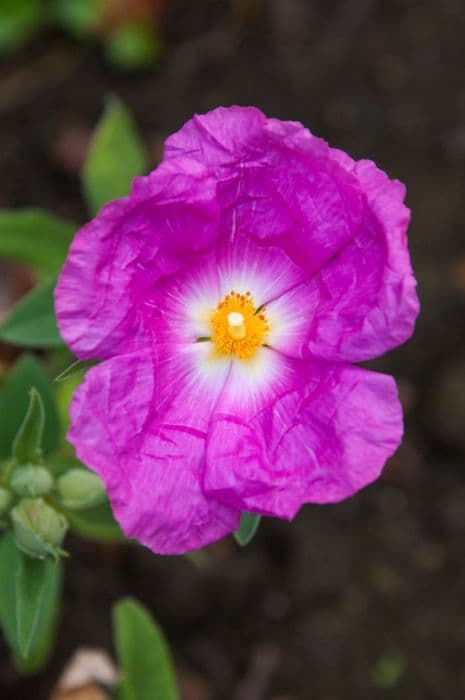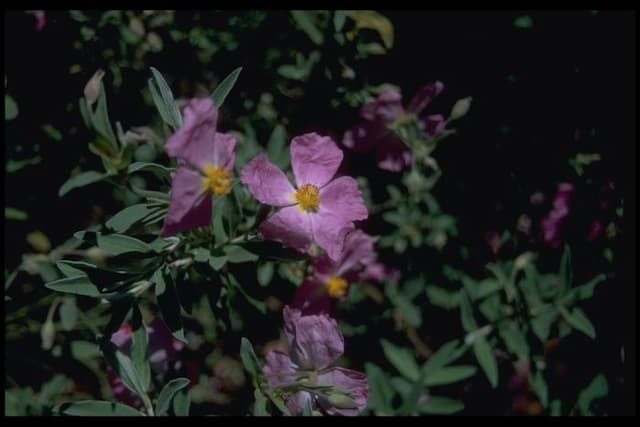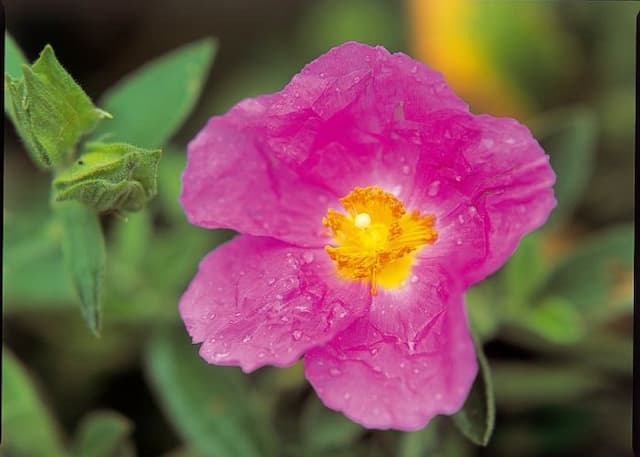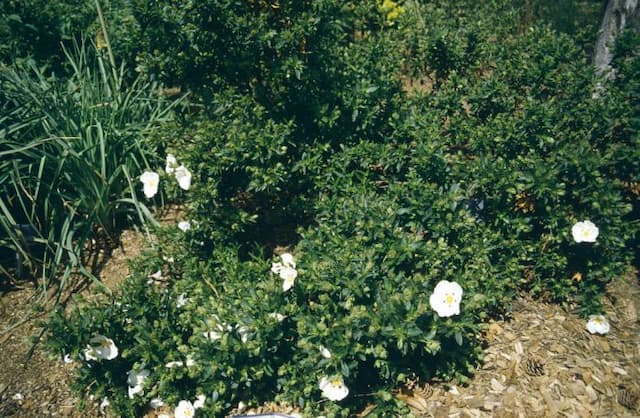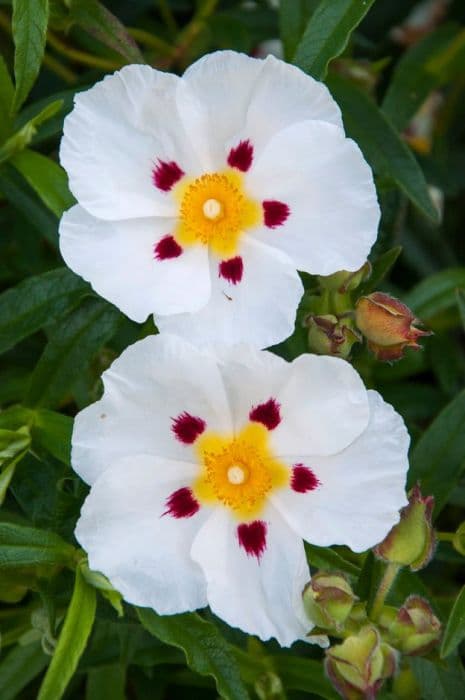Rock Rose Cistus × dansereaui

ABOUT
Commonly known as Rock Rose, this plant is recognized for its ornamental value in gardens. It boasts a shrub-like form with a dense, bushy appearance. It typically has evergreen foliage, which means it retains its leaves throughout the year. The leaves of Rock Rose are usually dark green, often with a slightly sticky texture, giving them a leathery look and feel. The Rock Rose is celebrated for its showy flowers. These blooms are large and delicate, with five papery petals that can range in color. Common hues for the blooms include white, pink, and purplish shades, frequently adorned with a distinct maroon or reddish blotch at the base of each petal. The flowers are typically around 2-3 inches across and are solitary or arranged in small clusters. They have a short lifespan, often only lasting for a single day, but the plant compensates by producing a profusion of blooms over the blooming period. Another characteristic feature of this plant is its prominent stamens, which form a conspicuous central bunch, adding to the visual appeal of the flowers. These stamens are usually yellow, creating a striking contrast against the petals. The Rock Rose is often grown for its resilience and its ability to thrive in tough, dry conditions, making it a popular choice for gardeners seeking a low-maintenance yet visually striking plant. Its overall appearance blends well in Mediterranean-style landscapes, rock gardens, and coastal gardens, where its floral display adds color and interest.
About this plant
 Names
NamesFamily
Cistaceae
Synonyms
Decumbens Rock Rose, Dansereau's Rockrose, Dansereau's Cistus
Common names
Cistus × dansereaui.
 Toxicity
ToxicityTo humans
Rockrose (Cistus × dansereaui) is generally not known to be toxic to humans. There are no well-documented cases or widespread evidence of toxicity from the ingestion of this plant. Therefore, no specific symptoms of poisoning are associated with the rockrose. However, as with any plant, individual allergies or sensitivities may occur, and it is generally not advisable to eat ornamental plants.
To pets
Rockrose (Cistus × dansereaui) is also not recognized as toxic to pets. There are no significant reports of poisoning in domestic animals such as dogs and cats from ingestion of this plant. While it is unlikely to cause harm, it is still recommended to prevent pets from eating ornamental plants as a precautionary measure due to potential individual sensitivities.
 Characteristics
CharacteristicsLife cycle
Perennials
Foliage type
Evergreen
Color of leaves
Green
Flower color
White
Height
3 feet (0.91 meters)
Spread
3 feet (0.91 meters)
Plant type
Shrub
Hardiness zones
8
Native area
Mediterranean
Benefits
 General Benefits
General Benefits- Drought Tolerance: Cistus × dansereaui, commonly known as Rockrose, is highly tolerant of drought conditions, making it suitable for xeriscaping and low-water gardens.
- Low Maintenance: Rockrose requires minimal care once established, needing little to no fertilization or pruning.
- Attracts Pollinators: With its showy flowers, the plant attracts bees and other pollinators, supporting local ecosystems.
- Fast Growth: Rockrose can grow quickly, providing a rapid fill for bare spots in the garden and creating a full, lush appearance.
- Erosion Control: The plant's root system helps stabilize slopes and areas prone to erosion.
- Decorative Flowers: The Rockrose has ornamental value thanks to its attractive and abundant flowers, enhancing the aesthetic appeal of landscapes.
- Deer Resistance: Typically, Rockrose is not favored by deer, which can be beneficial in areas where deer browsing is a problem.
- Adaptability: It is able to adapt to a wide range of soil types and PH levels, as long as there is good drainage.
- Evergreen Foliage: The Rockrose maintains its leaves throughout the year, providing continual greenery and structure to garden settings.
 Medical Properties
Medical PropertiesThis plant is not used for medical purposes.
 Air-purifying Qualities
Air-purifying QualitiesThis plant is not specifically known for air purifying qualities.
 Other Uses
Other Uses- Cistus × dansereaui, commonly known as the Rock Rose, can be used as a natural dye, with parts of the plant providing shades of tan or grey to fabrics when used in traditional dyeing practices.
- In landscape design, Rock Rose is often used for erosion control on slopes and hillsides due to its extensive root system, which helps stabilize the soil.
- Rock Rose can be used as a companion plant in gardens, attracting pollinators such as bees, which in turn can improve the pollination and yield of nearby fruit and vegetable crops.
- Due to its resinous leaves, Rock Rose can be considered as a potential natural fire retardant plant in fire-prone regions to create defensible space in landscaping.
- The fragrant foliage of Rock Rose is occasionally used in potpourri blends to add a pleasant aroma to indoor environments.
- This plant can be incorporated into permaculture designs as a drought-resistant option for creating sustainable and low-maintenance gardens.
- Rock Rose can be used as a habitat plant, offering shelter and food for various species of insects and birds within its dense foliage.
- It is sometimes planted in coastal areas because of its tolerance to salt sprays, making it ideal for seaside gardens or landscapes.
- Rock Rose is occasionally used as a living mulch, where it suppresses weeds with its spreading habit, while also conserving soil moisture.
- Hedging possibilities with Rock Rose exist due to its fast growth and ease of pruning, allowing gardeners to create low, informal hedges or borders in their outdoor spaces.
Interesting Facts
 Feng Shui
Feng ShuiThe Rockrose is not used in Feng Shui practice.
 Zodiac Sign Compitability
Zodiac Sign CompitabilityThe Rockrose is not used in astrology practice.
 Plant Symbolism
Plant Symbolism- Resilience: The Rock Rose (Cistus × dansereaui) is known for its ability to survive in dry and rocky soils, symbolizing the strength and resilience to thrive in challenging conditions.
- Beauty: With its attractive flowers, the Rock Rose represents beauty and the appreciation for the aesthetics in nature.
- Healing: Historically, some species of Cistus have been used in traditional medicine, thus symbolizing healing and restoration.
- Protection: The Rock Rose's ability to grow and form a protective shrubbery can be symbolic of providing shelter and safety.
- Transient Nature: The flowers of the Rock Rose often last only for a single day, which can symbolize the transient nature of life and the importance of living in the moment.
 Water
WaterRockrose plants, including Cistus × dansereaui, prefer a well-draining soil and do not require frequent watering once established. During the first growing season, water the plant deeply once a week to help establish an extensive root system. After the first year, reduce watering to every other week, providing about 1-2 gallons of water per session, depending on the climate and soil conditions. During hot, dry spells, increase the frequency slightly but avoid overwatering as rockrose is drought tolerant. The key is to water deeply and allow the soil to dry out between waterings to prevent root rot.
 Light
LightRockrose thrives in full sun conditions where it can receive at least six hours of direct sunlight daily. The ideal spot for Cistus × dansereaui is in a location that is exposed to unfiltered sunlight for the majority of the day. If planted in too much shade, the plant may not blossom as profusely and can become leggy. Ensuring sufficient light will promote robust growth and a plentiful display of flowers.
 Temperature
TemperatureRockrose requires a temperate climate and can tolerate a range of temperatures. Ideally, Cistus × dansereaui should be kept in conditions where temperatures range between 50°F and 75°F. It can withstand minimum temperatures down to around 15°F but may become damaged if exposed to temperatures below this threshold. Rockrose is generally not suited for extremely cold climates and benefits from protection if a frost is expected.
 Pruning
PruningPruning rockrose is generally done to shape the plant, remove any dead or damaged wood, and encourage new growth. Cistus × dansereaui should be pruned lightly immediately after flowering, which is typically in late spring or early summer. Avoid heavy pruning as the plant may not recover well. The best time for pruning is when the flowers begin to fade, which will often stimulate a second flush of blooms.
 Cleaning
CleaningAs needed
 Soil
SoilRockrose prefers a well-draining soil mix with a slight acidic to neutral pH, typically between 6.0 and 7.5. A combination of loam or sandy soil amended with peat and some organic matter can support healthy growth.
 Repotting
RepottingRockrose plants are generally repotted every 2 to 3 years to refresh the soil. They should be repotted in spring before the onset of new growth.
 Humidity & Misting
Humidity & MistingRockrose plants thrive in moderate to low humidity levels, adapting well to the typical range found in a Mediterranean climate.
 Suitable locations
Suitable locationsIndoor
Place rockrose in bright light and pot in well-draining soil.
Outdoor
Plant in full sun, well-drained soil, and water sparingly.
Hardiness zone
8-11 USDA
 Life cycle
Life cycleCistus × dansereaui, commonly known as White Rock Rose, begins its life cycle when seeds germinate in spring, typically requiring a warm temperature and well-drained soil. The seedlings grow into young plants with a rapid growth rate, developing characteristic resinous, sticky leaves and woody stems. Throughout spring and summer, the plant enters a flowering stage, displaying its white flowers with maroon spots at the base of the petals, each lasting a single day. After pollination, often by bees and other insects, the flowers produce capsules containing numerous small seeds. These seeds are dispersed by wind or sometimes by wildlife, enabling the White Rock Rose to colonize new areas. The plant then either enters a dormant period during the colder months or in milder climates may remain evergreen, completing its life cycle once it succumbs to age, disease, or extreme weather conditions.
 Propogation
PropogationPropogation time
Spring-Early Summer
Cistus × dansereaui, commonly known as the Rock Rose, can be propagated through semi-hardwood cuttings. The best time to take these cuttings is during summer, when the plant is actively growing but the new growth has begun to mature and harden slightly. To propagate, cut a 4 to 6-inch long stem with a sharp, clean pair of shears, making sure to include several leaf nodes. Strip the lower leaves off and dip the cut end into rooting hormone, which will encourage root development. Then, insert the cutting into a well-draining potting mix, ensuring at least one or two nodes are buried where roots and potentially new shoots will form. Keep the soil moist but not waterlogged and place the pot in a warm spot with indirect light. Rooting can take several weeks, after which the cutting can be transplanted into the garden or a permanent pot.
